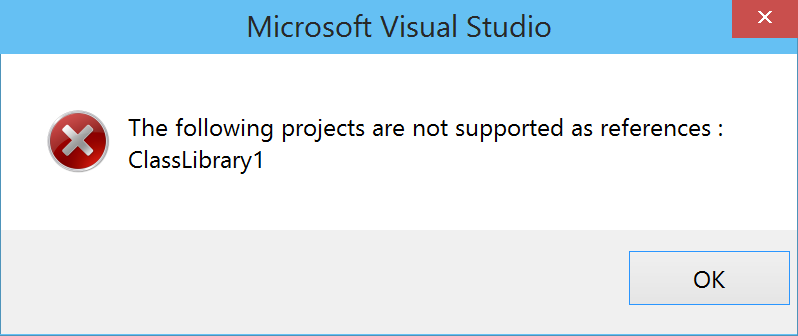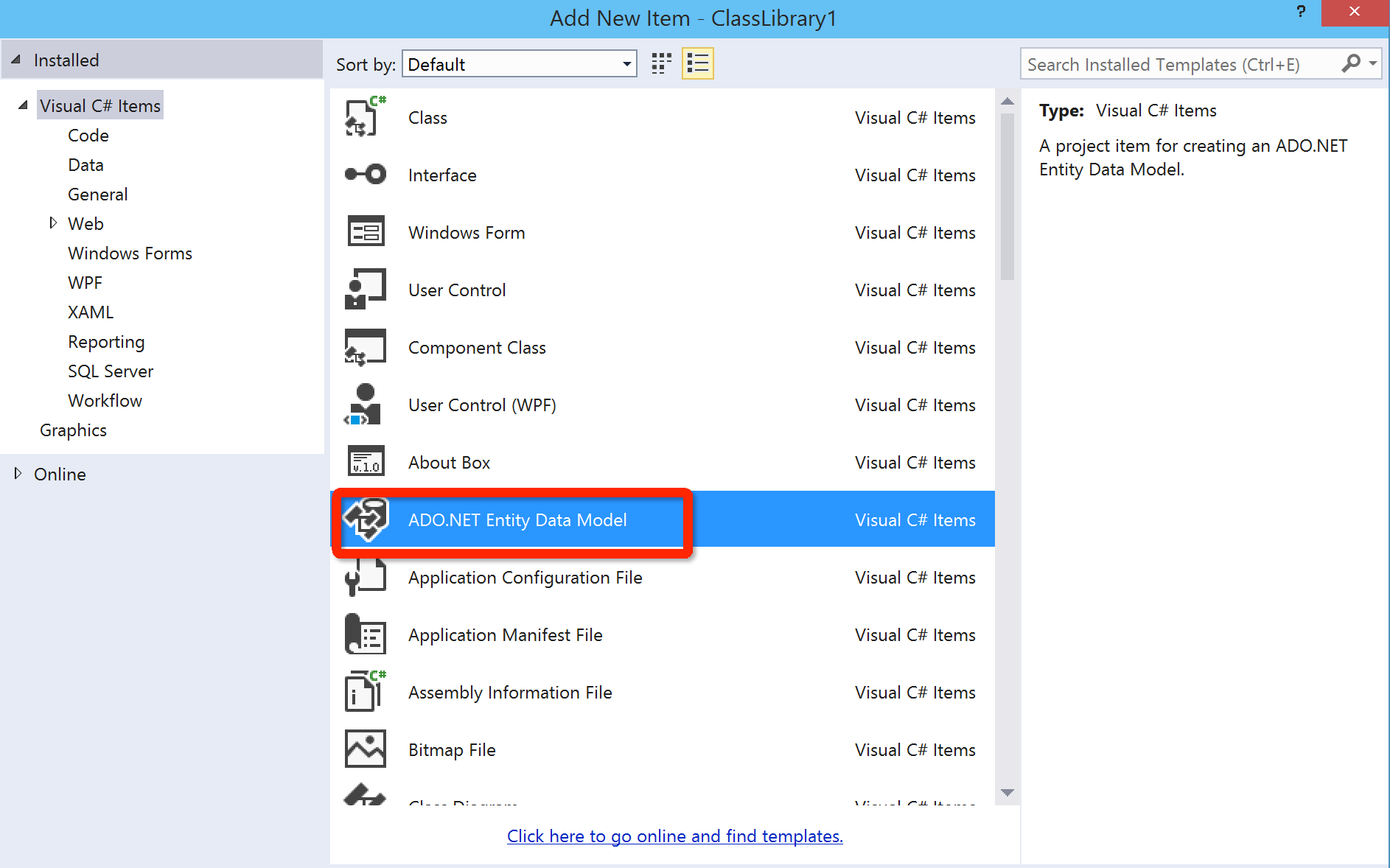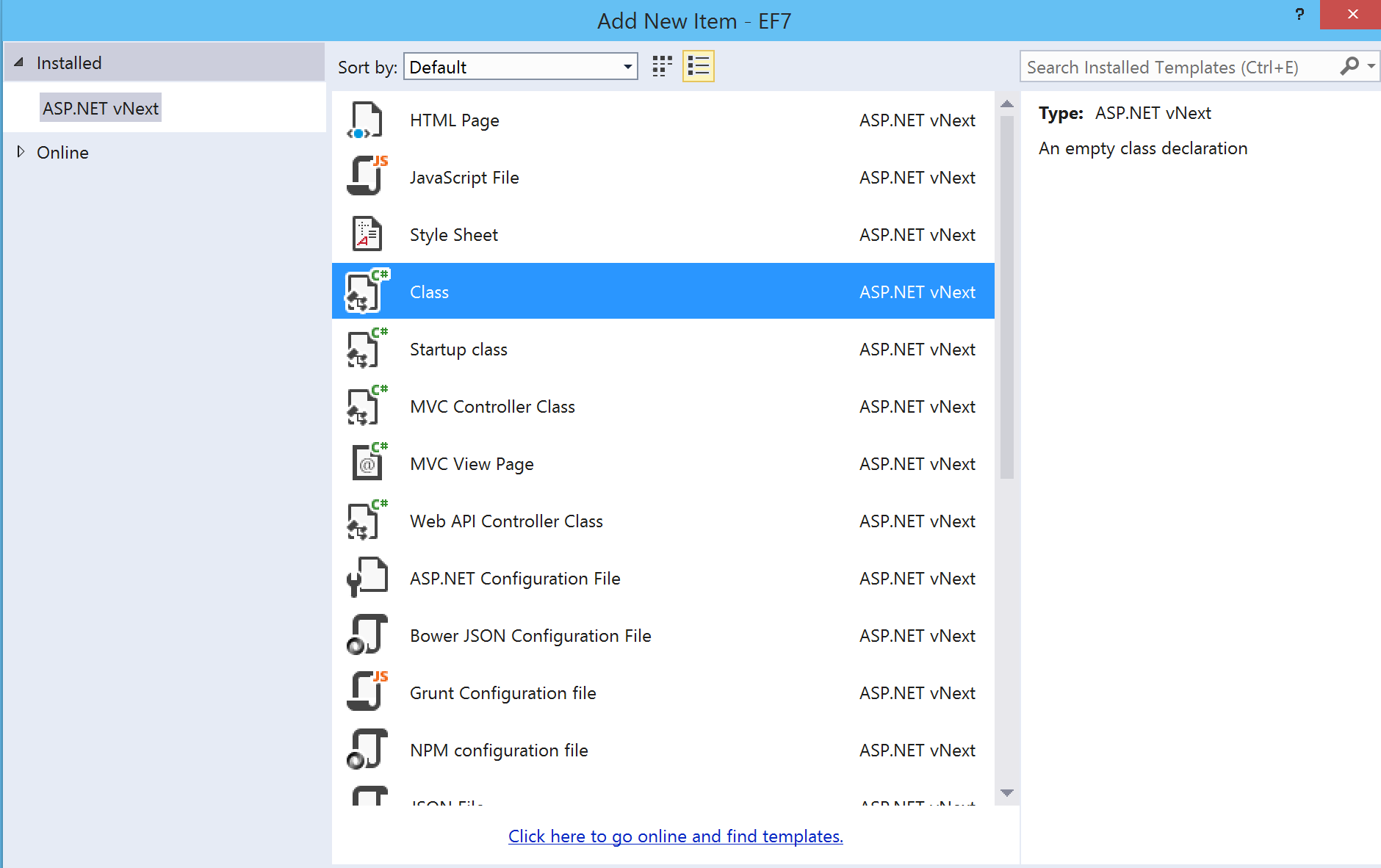EntityFramework 7 开发纪录
博文目录:
- 暂时开发模式
- Code First 具体体现
- DbContext 配置
- Entity 映射关联配置
- Migration 问题纪录(已解决)
之前的一篇博文:EF7 Code First Only-所引发的一些“臆想”
写这篇博文的缘由是:因为这次 EF7 更新比较大,很多东西都是全新模式,而且 EF7 相关的资料实在太少,所以只能通过 GitHub 上的 Entity Framework Wiki 进行参考学习,但资源有限,而且坑也不少,没办法,自己动手,丰衣足食。
下面说下我用 EF7 开发项目的一些笔记(待补充):
暂时开发模式
说明:The EF7 NuGet packages use some new metadata that is only supported in NuGet 2.8.3 or higher.
EF7 目前只能通过 NuGet 进行管理,所以,首先确定你的 Visual Studio 中的 NuGet 为最新版本(最低支持 2.8.3,最新版本 3.0)。
- Visual Studio 2015 - No updates needed, a compatible version of NuGet is included.
- Visual Studio 2013 - You can download a compatible version from Visual Studio Gallery. A compatible version is also included in VS 2013 Update 4.
- Visual Studio 2010 and 2012 - You can download a compatible version from Visual Studio Gallery.
然后需要在 Tools –> NuGet Package Manager –> Package Manager Settings 中配置 Package Sources:https://www.myget.org/F/aspnetvnext/api/v2/,VS 2015 不需要进行添加。
我使用的是 VS 2015 开发的,所以 NuGet 不需要任何配置,使用 EF 之前,需要添加一个类库项目。

这是 VS 2015 中 ASP.NET 5 的三种模版,首先需要明确的是,ASP.NET 5 Class Library 项目可以在其他两个项目之前进行引用,但不能被其他非 ASP.NET 5 项目引用,相反,ASP.NET 5 项目也不能引用其他类型的类库项目,如果强行引用,就会抱下面错误:

所以说,如果你的 Web 项目为 ASP.NET 5,那你开发的所有类库项目必须为 ASP.NET 5 Class Library 类型的。
Code First 具体体现
创建 ASP.NET 5 Class Library 类型的 EF7 项目,像平常 EF 开发一样,我们需要在 EF7 项目中添加项,但你会发现,选择项模版中并没有“ADO.NET Entity Date Model”项。
EF6:

EF7:

“ADO.NET Entity Date Model”,就是“Code First Only”的具体表现,没办法,EF7 逼着你自行写实体代码。
DbContext 配置
EF7DbContext 示例代码:
using Microsoft.Data.Entity;
using Microsoft.Data.Entity.Metadata;
using System;
namespace EF7
{
public class EF7DbContext : DbContext
{
public DbSet<Entity> Entities { get; set; }
protected override void OnConfiguring(DbContextOptions builder)
{
builder.UseSqlServer(@"data source=.;initial catalog=EF7Db;integrated security=True;");
}
protected override void OnModelCreating(ModelBuilder modelBuilder)
{
modelBuilder.Entity<Entity>()
.ForRelational()
.Table("Entities");
modelBuilder.Entity<Entity>()
.Key(n => n.Id);
modelBuilder.Entity<Entity>()
.Property(t => t.Id)
.GenerateValuesOnAdd(false);
base.OnModelCreating(modelBuilder);
}
}
}
OnModelCreating 方法没有变化,变化的是内部实现,映射配置后面讲下,OnConfiguring 是新加入的,builder.UseSqlServer 的作用就是绑定连接字符串,相当于之前版本 App.config 中的 connectionStrings,这个配置也可以在 ASP.NET 5 Web 的 Startup.cs 中进行配置,如下:
public class Startup
{
public Startup(IHostingEnvironment env)
{
// Setup configuration sources.
Configuration = new Configuration()
.AddJsonFile("config.json")
.AddEnvironmentVariables();
}
public IConfiguration Configuration { get; set; }
// This method gets called by the runtime.
public void ConfigureServices(IServiceCollection services)
{
// Add EF services to the services container.
services.AddEntityFramework()
.AddSqlServer()
.AddDbContext<CNBlogsNewsDbContext>();
//.AddDbContext<CNBlogsNewsDbContext>(options =>
//{
// //options.UseSqlServer(Configuration.Get("Data:DefaultConnection:ConnectionString"));
// options.UseSqlServer();
//});
// Add MVC services to the services container.
services.AddMvc();
// Uncomment the following line to add Web API servcies which makes it easier to port Web API 2 controllers.
// You need to add Microsoft.AspNet.Mvc.WebApiCompatShim package to project.json
// services.AddWebApiConventions();
}
}
AddEntityFramework 的配置模式有很多,比如上面配置中就不使用 EF7DbContext 中的连接字符串,而是读取 config.json 配置文件中的 ConnectionString,详细内容在 ASP.NET 5 记录中再进行说明,在 EF7DbContext 的示例代码中,我们会发现没有了 EF7DbContext 构造函数,之前都是在构造函数中写一大堆东西,比如:
public EF6DbContext()
: base("name=EF6Db")
{
this.Configuration.LazyLoadingEnabled = false;
Database.SetInitializer<EF6DbContext>(null);
}
这部分配置都移到 EF7DbContext 中的 OnConfiguring(DbContextOptions) 进行配置。
更多内容,请参考:Configuring a DbContext
Entity 映射关联配置
示例代码:
protected override void OnModelCreating(ModelBuilder modelBuilder)
{
modelBuilder.Entity<Entity>()
.ForRelational()
.Table("Entities");
modelBuilder.Entity<Entity>()
.Key(n => n.Id);
modelBuilder.Entity<Entity>()
.Property(t => t.Id)
.GenerateValuesOnAdd(false);
modelBuilder.Entity<ChildEntity>()
.Key(n => n.Id);
modelBuilder.Entity<ChildEntity>()
.ManyToOne(n => n.Entity, t => t.ChildEntities)
.ForeignKey(t => t.EntityId);
base.OnModelCreating(modelBuilder);
}
对 Entity 属性的一些配置,我们也可以在属性的上面进行配置(比如 Key、Required、DataType 等),命令空间:System.ComponentModel.DataAnnotations,Table 配置是我无意间发现的,我原以为 EF7 不能对 Entity 进行表的重命名,之前我记得在 EF6 中是有 ToTable() 方法的,或者在 Entity 上面进行 Table() 属性配置,但在 EF7 中改为了 ForRelational,所在程序集为:EntityFramework.Relational,GenerateValuesOnAdd 的配置说明是否为 identity,之前 EF 版本配置为:HasDatabaseGeneratedOption(DatabaseGeneratedOption.Identity),Entity 之间的关联配置:
- OneToOne:一对一
- OneToMany:一对多
- ManyToOne:多对一
EF7 Entity 之间的关联配置更加简单明了,EF 之前版本配置(HasOptional 或 HasRequired):
HasOptional(x => x.ParentMessage)
.WithMany()
.Map(x => x.MapKey("ParentID"))
//.HasForeignKey(c => c.ParentID)
.WillCascadeOnDelete(false);
Migration 问题纪录
参考:Using EF7 in Traditional .NET Applications
这是 EF7 的官方使用说明,其中有提到 Migration(迁移)的部分用法,其实很简单,总共就四步:
Install-Package EntityFramework.SqlServer –PreInstall-Package EntityFramework.Commands -PreAdd-Migration MyFirstMigrationApply-Migration
EF7DbContext 并不需要任何配置,但试过之后会发现,一大堆的问题,而且解决方案也搜不到,已经困扰一两天的时间了,下面纪录下过程。
之前写过一篇 EF Code First 的博文,里面有提到 EF 代码迁移的使用方法(非 EF7 版本),大致为:
Enable-MigrationsAdd-Migration Update-NewType-NameUpdate-Database
EF 7 代码迁移命令的完整说明(来自 get-help {命令名称} -full):
Use-DbContext [-Context] <string> [[-Project] <string>] [<CommonParameters>]Add-Migration [-Name] <string> [[-Context] <string>] [[-Project] <string>] [<CommonParameters>]Apply-Migration [[-Migration] <string>] [[-Context] <string>] [[-Project] <string>] [<CommonParameters>]Update-Database [[-Migration] <string>] [[-Context] <string>] [[-Project] <string>] [<CommonParameters>]Script-Migration [[-From] <string>] [[-To] <string>] [[-Context] <string>] [[-Project] <string>] [-Idempotent] [<CommonParameters>]
首先,按照EF7 Wiki 说明,在 Package Manager Console 中输入:Add-Migration MyFirstMigration 命令,会报如下错误:

异常完整信息:Add-Migration : The term 'Add-Migration' is not recognized as the name of a cmdlet, function, script file, or operable program. Check the spelling of the name, or if a path was in.
什么意思呢?直接说就是找不到“Add-Migration”命令,EF7 Migration 的所有命令管理都在 EntityFramework.Commands 程序集,所以我们使用 Migration 之前,都必须 NuGet 安装一下,找不到“Add-Migration”命令,这个问题困扰我很久,也没有找到相关资料,因为 Migration 的命令方式都是 PowerShell,我对这东西一窍不通,没办法,后来我尝试不使用 EF7,而是使用 EF6 进行 Migration 配置,发现是可以的,这就很奇怪,回过头再用 EF7 输入命令“Add-Migration”,就会报另一种错误:

异常完整信息:Join-Path : Cannot bind argument to parameter 'Path' because it is null.At C:\Users\yuezhongxin\Desktop\ConsoleApp1\packages\EntityFramework.6.1.1\tools\EntityFramework.psm1:713 char:28
什么意思?就是因为“Path”参数问题,不能加载“Add-Migration”命令,和上面异常不同的是,这个异常给出错误地址了:“EntityFramework.6.1.1\tools\EntityFramework.psm1”,但有个问题是,我使用的是 EF7,为什么会报 EntityFramework.6.1.1 的异常,这个问题也困扰我很久,最后在一篇博文中找到答案及解决方式:Entity Framework 5.0系列之Code First数据库迁移,大致意思是说 Migration 命令没有加载最新版本的 EntityFramework,所以需要在 Package Manager Console 中手动配置一下:
Import-Module C:\Users\yuezhongxin\.kpm\packages\EntityFramework.Commands\7.0.0-beta1\tools\EntityFramework.psd1Install-Package EntityFramework.Commands -IncludePrerelease
在 EF 之前版本中 EntityFramework.psd1 文件位置都会在 EntityFramework 程序集文件中,但在 EF7 中,被分离在了 EntityFramework.Commands 程序集文件中了,第二步的作用是重新加载程序集。

异常完整信息:The names of some imported commands from the module 'EntityFramework' include unapproved verbs that might make them less discoverable. To find the commands with unapproved verbs, run the Import-Module command again with the Verbose parameter. For a list of approved verbs, type Get-Verb.
Import-Module EF6 是成功的,但 Import-Module EF7 就会出现上面的警告信息,具体原因不得而知,在 Package Manager Console 中输入“Add-Migration MyFirstMigration”命令,会出现下面异常:

异常完整信息:Add-Migration : Cannot bind argument to parameter 'Path' because it is null.At line:1 char:1
但输入“get-help Add-Migration -full”命令(查看 Add-Migration 帮助信息),就会发现 Add-Migration 命令并没有任何问题,也就是说 EntityFramework.Commands 是可以使用的:

其实问题出现的原因无非就是两点:
- EntityFramework.Commands 中的 Migration 命令
- EF7DbContext 配置
网上关于 EF7 Migration 的资料实在少得可怜,这个问题我也只探究到这一步,毕竟还要做事,就纪录到这,等待后续解决!
》》》》》》》》》》》》》》》》》》》》》华丽分割线,EF7 Migration 问题解决《《《《《《《《《《《《《《《《《《《《《
原本已经放弃 EF7 Migration,这篇博文也只是做一个问题记录,但博文发布出来有一位园友 codepat,在评论中附带了一个 EF7 Migration 参考地址:http://www.asp.net/vnext/overview/aspnet-vnext/vc,主要是说明 EF7 Migration 的操作通过 KVM 完成,我上面所有的尝试都是通过 Package Manager Console 命令完成的,后来 EF wiki 上也更新了一篇 KVM 命令的博文:Migrations commands (high-level experience),但文中只是简单说了几个命令,并没有详细讲述,“Migrations commands (high-level experience)”,这个命名不知道是不是说明原来 Package Manager Console 命令已经不能使用,也就是上面一直出现的报错问题,还是 EF7 Migration 只能通过 KVM 命令进行操作,下面纪录下使用 KVM 的操作步骤:
- 命令行运行(安装 KVM):
@powershell -NoProfile -ExecutionPolicy unrestricted -Command "iex ((new-object net.webclient).DownloadString('https://raw.githubusercontent.com/aspnet/Home/master/kvminstall.ps1'))" - 退出命令行,再次打开,输入命令:
KVM upgrade - cd 转到 EF7 项目下(project.json 所在目录),如:
cd C:\Users\yuezhongxin\Desktop\EF7\src\EF7 - 增加迁移命令:
k ef migration add initial - 应用迁移命令:
k ef migration apply
project.json 示例代码:
{
"version": "1.0.0-*",
"dependencies": {
"EntityFramework.SqlServer": "7.0.0-beta1",
"EntityFramework.Commands": "7.0.0-beta1",
"EntityFramework": "7.0.0-beta1",
"EntityFramework.Migrations": "7.0.0-beta1",
"EntityFramework.Relational": "7.0.0-beta1"
},
"commands": {
"ef": "EntityFramework.Commands"
},
"frameworks" : {
"aspnet50" : {
"dependencies": {
}
},
"aspnetcore50" : {
"dependencies": {
"System.Runtime": "4.0.20-beta-22231"
}
}
}
}
运行操作图:

困扰几天的问题终于解决了,这种感觉比中 500W 的彩票还要好,再次感谢园友 codepat。
珍贵的参考资料:
- Getting Started with EF7 Nightly Builds
- What is EF7 all about
- MusicStore
- Using EF7 in Traditional .NET Applications
- Configuring a DbContext
- Getting started with ASP.NET 5 MVC 6 Web API & Entity Framework 7
- Migrations commands (high-level experience)
- Code First Migrations
- Entity Framework 5.0系列之Code First数据库迁移
- EF7 NuGet Commands
- EF Migrations Command Reference
- Using EF7 in Windows Phone & Store Applications
微信公众号:你好架构
出处:http://www.cnblogs.com/xishuai/
公众号会不定时的分享有关架构的方方面面,包含并不局限于:Microservices(微服务)、Service Mesh(服务网格)、DDD/TDD、Spring Cloud、Dubbo、Service Fabric、Linkerd、Envoy、Istio、Conduit、Kubernetes、Docker、MacOS/Linux、Java、.NET Core/ASP.NET Core、Redis、RabbitMQ、MongoDB、GitLab、CI/CD(持续集成/持续部署)、DevOps等等。
本文版权归作者和博客园共有,欢迎转载,但未经作者同意必须保留此段声明,且在文章页面明显位置给出原文连接。







【推荐】编程新体验,更懂你的AI,立即体验豆包MarsCode编程助手
【推荐】凌霞软件回馈社区,博客园 & 1Panel & Halo 联合会员上线
【推荐】抖音旗下AI助手豆包,你的智能百科全书,全免费不限次数
【推荐】博客园社区专享云产品让利特惠,阿里云新客6.5折上折
【推荐】轻量又高性能的 SSH 工具 IShell:AI 加持,快人一步
· 没有源码,如何修改代码逻辑?
· 一个奇形怪状的面试题:Bean中的CHM要不要加volatile?
· [.NET]调用本地 Deepseek 模型
· 一个费力不讨好的项目,让我损失了近一半的绩效!
· .NET Core 托管堆内存泄露/CPU异常的常见思路
· 微软正式发布.NET 10 Preview 1:开启下一代开发框架新篇章
· 没有源码,如何修改代码逻辑?
· NetPad:一个.NET开源、跨平台的C#编辑器
· PowerShell开发游戏 · 打蜜蜂
· 在鹅厂做java开发是什么体验